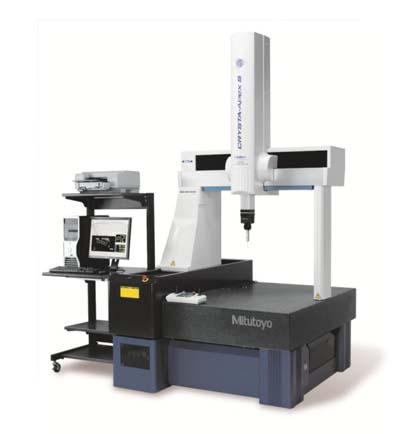
The new CRYSTA-Apex S Coordinate Measuring Machine from Mitutoyo America Corp. brings new levels of performance and economy to the 1.7µm class of CNC CMMs. With a maximum error of MPEE = (1.7+3L/1000)µm, the new Mitutoyo CRYSTA-Apex S more than doubles the effective measuring range at a given measurement tolerance as compared to typical CMMs in its class. Additionally, the CRYSTA-Apex S drive features high-speed (max 519mm/s) and high acceleration (max 2,309mm/s2). These advances result in higher throughput for greater productivity and lower total owning and operating costs.
The CRYSTA-Apex S uses the new UC-400 controller to manage digital servo system control loops for position, speed, and current. This makes it easy to implement various types of control algorithms. Additionally, the digital servo system has a wide dynamic range and is highly resistant to drift over time. Extreme rigidity helps the CRYSTA-Apex S maintain accuracy. The Y-axis guide rail is integrated into one side of the granite surface plate. Precision air bearings located on the bottom, front, rear and upper surfaces of the X-axis slider minimize vibration and ensure stability even during high-speed, high-acceleration operation.
Accuracy is further enhanced by an advanced Temperature Compensation System. The System consists of a thermometer unit that measures the temperatures from thermal sensors located on the scale units of the CMM main unit and from a set of workpiece thermal sensors. The temperature data is transferred to the UC-400 machine controller for thermal compensation.
For proper workpiece compensation, the thermal expansion coefficient of the workpiece material is entered by the user; since the material of scale units of the CMM is constant, this expansion coefficient is permanently stored in the temperature unit. The CRYSTA-Apex S supports a wide range of probes that offer increased capabilities including the MPP-310Q scanning probe that collects cloud point data at speeds of up to 120mm/s. Other probes suited for screw depth measurement, ultra-small diameter measurement and non-contact measurement are also supported.
Available software options enable the CRYSTA-Apex S to tackle a wide variety of measurement applications. Software packages include GEOPAK, a high-functionality general-purpose measurement program which is at the heart of MCOSMOS (Mitutoyo Controlled Open System for Modular Operation Support) software. MCOSMOS supports virtually every CAD format while providing routines for in-line measurement, data feedback, and process management. Additional software supported includes: CAT1000S for freeform surface evaluation; CAT1000P, an offline teaching program; SCANPAK, for contour measurement; and a range of programs supporting laser and vision probes. CRYSTA-Apex S provides USB communications for connectivity.
Additionally, CRYSTA-Apex®S supports MeasurLink STATMeasure Plus, Mitutoyo's proprietary statistical-processing and process-control program. MeasurLink STATMeasure Plus performs statistical analysis and provides real-time display of measurement results for SPC applications. The program can also be linked to a higher-level network environment for enterprise-wide functionality.
Contact Details
Related Glossary Terms
- computer numerical control ( CNC)
computer numerical control ( CNC)
Microprocessor-based controller dedicated to a machine tool that permits the creation or modification of parts. Programmed numerical control activates the machine’s servos and spindle drives and controls the various machining operations. See DNC, direct numerical control; NC, numerical control.
- computer-aided design ( CAD)
computer-aided design ( CAD)
Product-design functions performed with the help of computers and special software.
- statistical process control ( SPC)
statistical process control ( SPC)
Statistical techniques to measure and analyze the extent to which a process deviates from a set standard.
- tolerance
tolerance
Minimum and maximum amount a workpiece dimension is allowed to vary from a set standard and still be acceptable.
